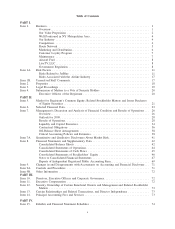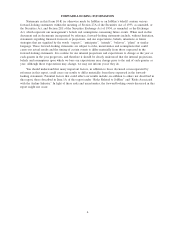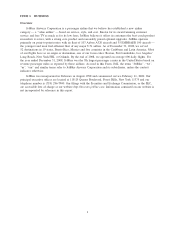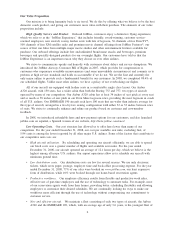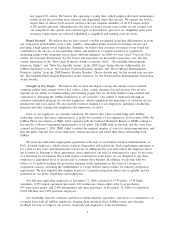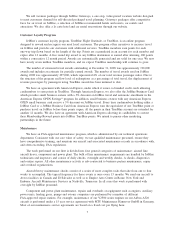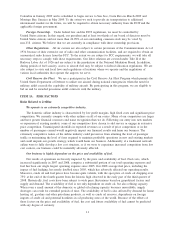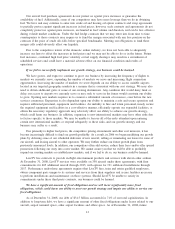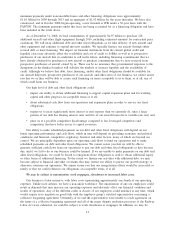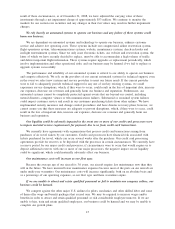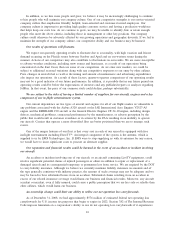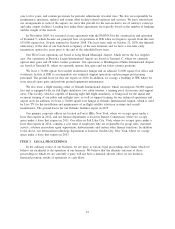JetBlue Airlines 2008 Annual Report Download - page 18
Download and view the complete annual report
Please find page 18 of the 2008 JetBlue Airlines annual report below. You can navigate through the pages in the report by either clicking on the pages listed below, or by using the keyword search tool below to find specific information within the annual report.penalties, revoke operating authority and seek criminal sanctions. In February 2000, the DOT granted us a
certificate of public convenience and necessity authorizing us to engage in air transportation within the
United States, its territories and possessions.
The FAA primarily regulates flight operations and, in particular, matters affecting air safety, such as
airworthiness requirements for aircraft, the licensing of pilots, mechanics and dispatchers, and the certification
of flight attendants. The civil aviation security functions of the FAA were transferred to the TSA under the
Aviation and Transportation Security Act. The FAA requires each airline to obtain an operating certificate
authorizing the airline to operate at specific airports using specified equipment. We have and maintain FAA
certificates of airworthiness for all of our aircraft and have the necessary FAA authority to fly to all of the
cities that we currently serve.
Like all U.S. certified carriers, we cannot fly to new destinations without the prior authorization of the
FAA. The FAA has the authority to modify, suspend temporarily or revoke permanently our authority to
provide air transportation or that of our licensed personnel, after providing notice and a hearing, for failure to
comply with FAA regulations. The FAA can assess civil penalties for such failures or institute proceedings for
the imposition and collection of monetary fines for the violation of certain FAA regulations. The FAA can
revoke our authority to provide air transportation on an emergency basis, without providing notice and a
hearing, where significant safety issues are involved. The FAA monitors our compliance with maintenance,
flight operations and safety regulations, maintains onsite representatives and performs frequent spot
inspections of our aircraft, employees and records.
The FAA also has the authority to issue maintenance directives and other mandatory orders relating to,
among other things, inspection of aircraft and engines, fire retardant and smoke detection devices, increased
security precautions, collision and windshear avoidance systems, noise abatement and the mandatory removal
and replacement of aircraft parts that have failed or may fail in the future.
The TSA operates under the Department of Homeland Security and is responsible for all civil aviation
security, including passenger and baggage screening, cargo security measures, airport security, assessment and
distribution of intelligence, and security research and development. The TSA also has law enforcement powers
and the authority to issue regulations, including in cases of national emergency, without a notice or comment
period.
We believe that we are operating in material compliance with DOT, FAA and TSA regulations and hold
all necessary operating and airworthiness authorizations and certificates. Should any of these authorizations or
certificates be modified, suspended or revoked, our business could be materially adversely affected.
We are also subject to state and local laws and regulations in a number of states in which we operate.
Airport Access. In January 2007, the High Density Rule, established by the FAA in 1968 to limit the
number of scheduled flights at JFK from 3:00 p.m. to 7:59 p.m., expired. As a result, like nearly every other
airport, the number of flights at JFK was no longer regulated and airlines became able to schedule flights
without restrictions. As a result of over-scheduling beyond the airport’s hourly capacity, congestion and delays
increased significantly in 2007.
Historically, JFK experienced congestion only from the late afternoon to the early evening during the
peak international traffic period because of longer separations required between the aircraft movements.
However, over the past few years, JFK has become increasingly busy and the significant increase in arrivals
and departures has created peak periods that regularly overload the current Air Traffic Control, or ATC,
system. ATC ground delay programs at the New York metropolitan area airports have become the rule, rather
than the exception, during the peak travel periods, and restrictions have been imposed on most of the
operational hours in the day. We continue to work actively with the Port Authority of New York and New
Jersey, or PANYNJ, and the FAA, to find solutions to ease this congestion. In 2008, the FAA imposed slot
restrictions and hourly operational caps at JFK and Newark’s Liberty International Airport in an effort to ease
congestion in the New York metropolitan area airspace, with the goal of reducing system congestion. Despite
this action, 2008 was one of the most challenging years for disruptive operations in the New York
metropolitan area, even worse than 2007, prior to the hourly caps imposed by the FAA. Contributing to these
9


